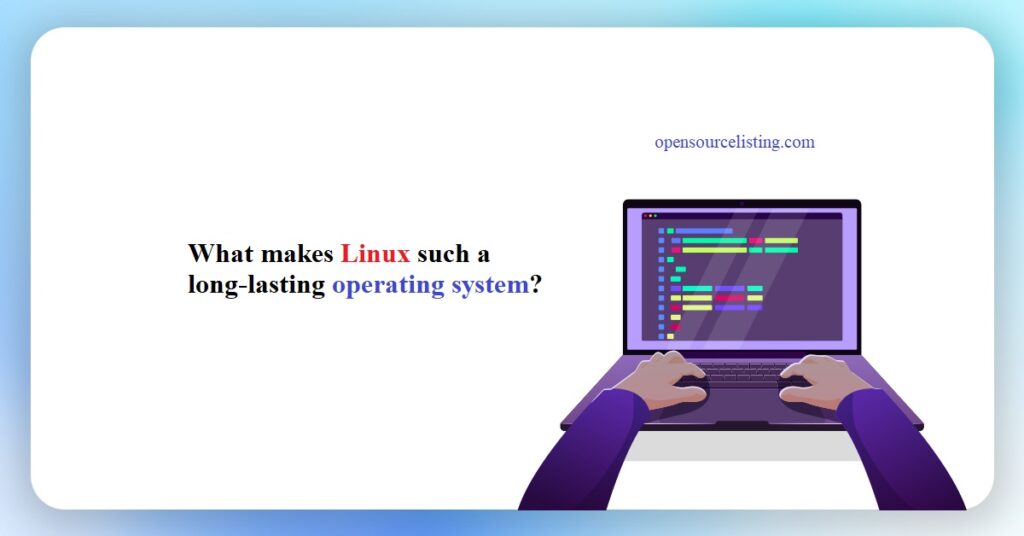What makes Linux such a long-lasting operating system?
Linux is an environmentally friendly operating system since it helps to bridge the digital gap and increase the life of technology. Fighting the pandemic has resulted in a shortage of microchips, which are required to build new computers. Furthermore, some modern proprietary operating systems come with stricter minimum requirements.
To begin with, he claims that because Linux uses less processor power and less complex technology than Windows or Mac OS X, you may keep your hardware for much longer. This means fewer landfill issues and less new equipment manufacturing overall. He cites a 2004 research conducted by the UK Office of Government Commerce, which asserts that Windows users must upgrade their computers twice as often as Linux users. “Typical hardware refresh length for Microsoft Windows systems is three to four years,” according to the research, “while a large UK manufacturing group claims six to eight year hardware refresh interval for Linux systems.”

Wallen also claims that Red Hat Linux consumes less energy than Windows Server 2008, citing a research that claims Red Hat Linux servers outperformed Windows Server 2008 in 13 of 16 energy consumption tests.
Many of his other arguments, on the other hand, aren’t always valid, and some of them aren’t really comparisons of Linux to other operating systems, but rather tips on how to make Linux more environmentally friendly. He cites netbooks as proof that Linux is more environmentally friendly than other operating systems, but these days, 80 percent or more of all netbooks come preloaded with Windows, so the argument falls flat.
FreeGeek and the Kramden Institute, for example, have made it their fundamental purpose to cross the digital gap. These organizations have repurposed obsolete computers, keeping them out of landfills and placing them in the hands of people who require them. Those programs would not be possible without Linux.
DD-Wrt, OpenWrt, and Tomato are all Linux-based router solutions that keep obsolete network hardware out of landfills while also improving security, privacy, and performance.
Linux has opened up doors that would not have been possible otherwise. Thanks to principles learnt on ancient machines, students and enthusiasts alike have launched successful careers in computer science with no investment. These systems run enterprise-grade software, such as the LAMP stack, which aided the “Web 2.0” shift. It was one of the first web-based open source software stacks. It now powers installations of WordPress, Drupal, and Joomla. In fact, Linux is used by 96 percent of the top one million web servers on the planet. Embedded systems, e-readers, smart televisions, smartwatches, and other devices are all managed by Linux. Over 70% of smartphones use Linux as their operating system. Linux is also used by NASA’s Perseverance Rover, which made history on Mars this year.
Linux is a long-lasting operating system that has been in development for more than three decades. It has become one of the most popular and widely used operating systems in the world, powering everything from servers and mainframes to smartphones and smart TVs. There are several key factors that have contributed to the longevity and success of Linux as an operating system.
One of the most significant advantages of Linux is that it is open-source software. This means that the source code for Linux is freely available for anyone to use, modify, and distribute. This has created a large community of developers and users who work together to improve and enhance the operating system over time. Because of this collaborative effort, Linux has evolved into a stable, secure, and feature-rich operating system that is suitable for a wide range of applications.
Another reason for the longevity of Linux is its flexibility and customizability. Linux is highly modular, which means that it can be tailored to specific needs and requirements. Users can choose from a variety of different distributions, each with its own set of features, tools, and applications. This flexibility allows Linux to be used in a wide range of devices and systems, from desktop computers and servers to embedded systems and Internet of Things (IoT) devices.
Linux is also known for its reliability and stability. Many versions of Linux are designed for use in mission-critical systems that require continuous operation without failure. This is due in part to the modular design of Linux, which makes it easier to isolate and fix problems when they occur. Additionally, Linux is less susceptible to malware and viruses than other operating systems, which enhances its overall security and stability.
Another advantage of Linux is its command-line interface and scripting languages. While some users may find this interface intimidating, it provides a great deal of power and flexibility to the user. The command-line interface allows users to automate tasks, perform complex operations, and customize their system to a greater extent than is possible with graphical user interfaces (GUIs). Additionally, scripting languages like Bash, Python, and Perl provide even greater power and flexibility, allowing users to write custom scripts to automate tasks and perform complex operations with ease.
Finally, Linux is supported by a large and dedicated community of developers and users. This community provides a wealth of resources, including documentation, tutorials, and support forums, that make it easy for new users to learn about Linux and get help when they need it. The community also contributes to the development of Linux by submitting bug reports, suggesting new features, and writing software that enhances the functionality of the operating system.
In summary, Linux is a long-lasting operating system that has endured for more than three decades due to its open-source nature, flexibility, reliability, command-line interface and scripting languages, and the support of a large and dedicated community. These factors have contributed to the ongoing success of Linux as an operating system and will likely continue to do so in the years to come.













